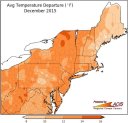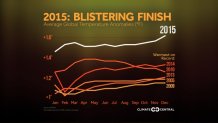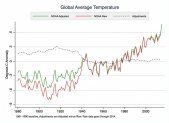RECORD DECEMBER
Winter 2015-16 started off as if there wouldn’t be any winter at all. December was the warmest ever recorded-not just around here, but in many areas east of the Rockies. And in many places, it wasn’t even close. This map shows it was a record warm December in EVERY state east of the Mississippi plus Missouri, Iowa, and Minnesota!

And that’s not all. Records like this are normally broken by a tenth or a few tenths of a degree. Many of those records were broken by several degrees. In Philadelphia, we were 13.7 degrees above normal, breaking the record by an amazing 6.7 degrees! This map shows just how far above normal December temperatures were:

The record December was a fitting finish to a shattering of the global temperature record of 2015:

THE BLIZZARD (AND CLIMATE CHANGE)
Local
Breaking news and the stories that matter to your neighborhood.
A season’s worth of snow fell in a single storm in late January, with true blizzard conditions reported in some parts of our area. Here is an official map and write-up on the storm: North Regional Climate Center's blog on January 2016 Blizzard.
After a big snowstorm or wicked cold blast (like the one last weekend), there will usually be a few comments on how this refutes the global warming consensus. We’ve even heard it from Congress. But, if anything, these monster snowstorms could be evidence that a warming world and ocean can contribute to bigger snowfalls. I wrote about this in my recent blog, The Ocean's Revenge.
I’m not the only one making the connection. There were several articles of this nature after the storm (and several predicting big future snowstorms months-or years-ahead of the event) including an article in The Washington post about how climate change may play an important role in the new era of great snowstorms. It’s an area of climate study called “Attribution Science”, and it has become gradually more accepted in the climate science community in the past year. But it’s still one of the areas that are often debated among climate scientists.
In case of an “inadvertent” misquote, I AM NOT SAYING THAT GLOBAL WARMING CAUSED THE BLIZZARD. It may have led to some increase in snowfall, though.
SPEAKING OF STORMS: SANDY & WARMER OCEANS
In case Superstorm Sandy wasn’t scary enough, a new study shows how much stronger a storm like that would be tracking in an ocean a lot warmer than it is now. The prestigious publication, Geophysical Research Letters, in an issue last month, showed the results of computer simulations of how Sandy would behave moving over warmer waters.
They ran five simulations. Two led to tracks similar to Sandy, but with 50-80% more destructive power, and 30-50% more rain. The other three had even bigger impacts, but the storm tracked away from the East Coast.
A couple of obvious conclusions:
- Warmer oceans lead to stronger storms and more precipitation
- Warmer oceans can affect the track of even the biggest storms
NO CONSPIRACY ON TEMPERATURE ADJUSTMENTS
A common complaint from those rejecting the global warming consensus is that temperature measurements are both inaccurate AND have been manipulated by scientists to make it look like the earth has warmed more than it really has. There have even been recent Congressional hearings on the subject.
A new study published in Geophysical Research Letters confirms what most climate scientists have been insisting on for years. That is: adjustments to temperature records over land and ocean are necessary and increase the overall accuracy of measuring temperature changes over years-and decades.
For example, if an instrument is moved, or affected more by urban heat, does that help corrupt the global record? In this study, scientists focused on the “pristine” instrument locations and found the same temperature trend as the “corrupted” ones since about 1940. After all, the arguments about global warming have been about how big the trend of warming is.

A February 2016 paper in the journal Science titled “Climate Confusion Among U.S. Teachers” shows how middle and high school science teachers talk about Climate Change. Climate scientists have been found in numerous studies to overwhelmingly agree with the IPCC that “global warming is caused mostly by human activities”. But only 30% of middle school and 45% of high school science teachers seem to be aware of that. This is why there is a lot of teaching “both sides” of the argument. It also is a safe choice in a volatile political issue.
Glenn “Hurricane” Schwartz
Chief Meteorologist, NBC10 Philadelphia



